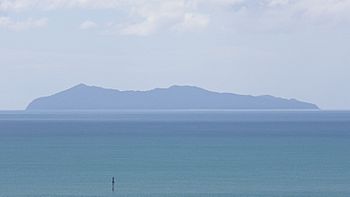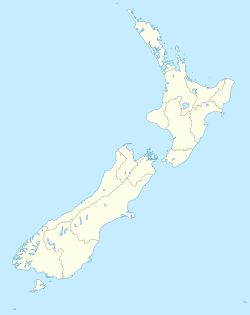Mayor Island / Tuhua facts for kids
|
Tuhua (Māori)
|
|
|---|---|

Mayor Island / Tuhua as seen from Mount Maunganui
|
|
| Geography | |
| Location | Bay of Plenty, North Island, New Zealand |
| Coordinates | 37°17′S 176°15′E / 37.283°S 176.250°E |
| Area | 13 km2 (5.0 sq mi) |
| Highest elevation | 355 m (1,165 ft) |
| Administration | |
| Demographics | |
| Population | 4 |
Mayor Island, also known as Tuhua in Māori, is a special island off the coast of New Zealand. It's actually a volcano that is currently sleeping, or "dormant." You can find it in the beautiful Bay of Plenty, near the North Island. The island is about 35 kilometers (22 miles) north of Tauranga. It covers an area of about 13 square kilometers (5 square miles).
Contents
Discovering Mayor Island / Tuhua
Mayor Island / Tuhua is a fascinating place. It is a shield volcano, which means it has a wide, gentle slope like a warrior's shield. The island rises 355 meters (1,165 feet) above the sea. It is quite steep along its coast.
The island is believed to have appeared from the sea about 7,000 years ago. On one side, the volcano goes down about 75 meters (246 feet) to the North Island. On the other side, it drops 400 to 500 meters (1,300 to 1,600 feet) to the seafloor.
Volcano Features
Mayor Island is known for its hot springs. It also has two small lakes inside old volcano craters. These are called Green Lake and Black Lake.
These lakes sit within two large bowl-shaped hollows called calderas. Calderas form when a volcano's magma chamber empties during a huge eruption, causing the ground above to collapse. The calderas on Mayor Island were formed by powerful eruptions 36,000 and 6,340 years ago.
This volcano has had many different kinds of eruptions. These include "fire fountains" (like giant fireworks) and "Strombolian explosions" (smaller, frequent blasts). It has also produced lava domes (thick, sticky lava piles) and "phreatomagmatic explosions" (steam blasts from magma mixing with water). Even "Plinian falls" (huge ash clouds) and "ignimbrite" (fast-moving hot ash and gas flows) have happened here. The most recent lava flows are thought to be between 500 and 1,000 years old.
History and Culture
Captain James Cook saw the island on November 3, 1769. He named it Mayor Island because Lord Mayor's Day was happening in London a few days later.
The Māori people, who are the native people of New Zealand, consider the island very special. This is partly because of a black, shiny volcanic glass found there. This glass is called obsidian. It forms when lava cools very quickly. Māori called this obsidian "Tuhua" and also gave the island the same name. Obsidian was highly valued as a sharp cutting tool. More than 80% of the obsidian found on Great Mercury Island came from Tuhua.
Nature and Activities
The waters around Mayor Island are famous for game fishing. You can find large fish like marlin, mako sharks, and swordfish here. However, the island and the waters near its shores are now a small marine reserve. This helps protect the sea creatures and their home.
There are several tramping (hiking) paths around the island. It is also a popular spot for divers who want to explore the underwater world.
Several old Māori fortified villages, known as Pā, are found on the island. The last of these villages was lived in until 1901. Today, Mayor Island is a safe place for wildlife. A few holiday houses are located in Opo Bay on the south coast of the island. In 2001, only four people lived on the island.


